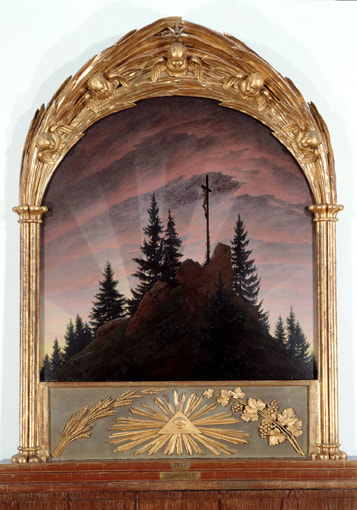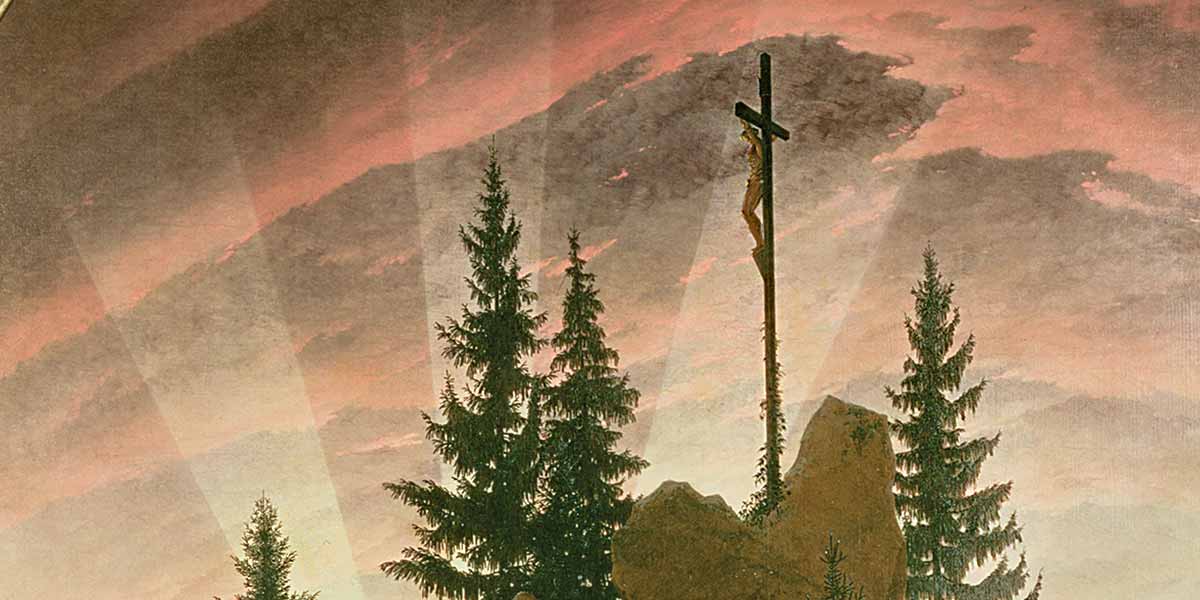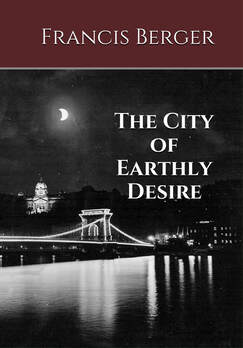Some critics complained of Friedrich's attempt to smuggle landscape painting into the church. Others were annoyed by the "Germanness" of the image. Others still by its Romantic elements, which they believed to be incompatible with Christianity.
For his part, Friedrich remained true to his Romantic notions that traditional Christian iconography placed a wedge between man and God. In this sense, Christ in the Mountains is Friedrich's solution to that wedge -- the wedge he and his fellow Romantics believed kept man from experiencing a mystical union with God.
For me, Cross in the Mountains represents the epitome of what Christianity comes down to now, which is Romantic Christianity.
The painting depicts the crucified Jesus on a lonely, silhouetted golden cross upon a rock in the mountains surrounded by fir trees. He faces the two sources of light, neither of which is naturalistic in style -- the light of a sunset or sunrise, and the light of divine that emerges in five pillar-like rays from the other side of the mountain.
Christ is not only alone, He is also turned away from the viewer, toward both the natural and divine light. The viewer stands nearby, presumably on a neighboring outcrop of rock. Christ is both close and distant; and though He does not face the viewer, His image beckons the viewer to bridge the chasm and ascend the peak upon which the cross stands.
No other human figures or constructions exist within the composition. No church, chapel, cabin, or bridge stands below. No climber scales the rock face toward the cross. The world is reduced to a mauve and gray wash of sky, the mountain, the trees, and Jesus on the cross -- and the cross stands alone. Christ is alone looking over the expanse of the earth and heavens. Yet He silently invites the viewer to draw closer -- to make the personal choice, to seize the moment of freedom, and to commit to the ascent.
The painting's first critics were correct. Cross in the Mountains is not classic Christian iconography. Yet this sort of criticism hardly qualifies as criticism at all because David Caspar Friedrich had not aimed to create classic Christian iconography. On the contrary, he had aimed to paint the sort of scene in which man could experience a mystical union with God.
In this sense, Cross in the Mountains is an extremely prescient, perhaps even prophetic painting. Though he had created the work in the early nineteenth century, Friedrich appeared to have sensed the inevitable decline of conventional, external, moderate, everyday Christianity -- the inevitable decline that culminated in Nietzsche's declaration of God's death toward the end of the same century.
This acute awareness of the fading and weakening of external, conventional Christianity inspired Friedrich to seek new, unexplored means through which man's connection with the divine could be both maintained and intensified. Instead of reviving traditional motifs, Friedrich embarked on a mystical path -- the path of individual free choice separated from all Christian externals save for the image of Christ Himself.
Cross in the Mountains is an important painting because it depicts what Christianity comes down to now. For me. For you. For everyone who desires to become a serious and genuine follower of Christ. It comes down to a decision that does not depend on any externals whatsoever, but a decision that comes from within the innermost parts of ourselves -- a decision inspired by gazing up at a cross upon a summit.
A decision inspired by the crucified Jesus who calls upon you to believe on Him, to take the risk and rise above the objectified, external world, ascend the mountain, and join Him at the peak. Nothing more is needed. In fact, anything else would be too much.
The kind of mystical union with God Friedrich depicts here is available to anyone at anytime. It may soon become the only kind of authentic union available. It doesn't require mountains, mauve and gray washes of sky, or summit crosses. All it requires your free commitment to believe on Jesus and the direct knowledge that God also believes on you.
Do that, with love, and the mystical union is sealed. Now and forever.



 RSS Feed
RSS Feed

